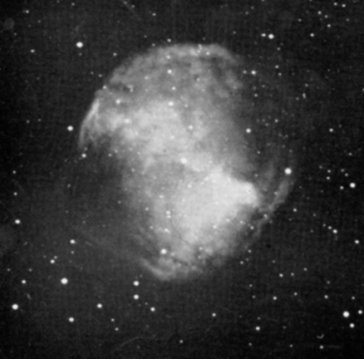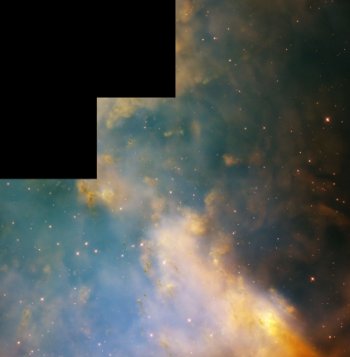NGC 6853
THE DUMBBELL NEBULA IN VULPECULA
MESSIER 27
"One of the 'giants' of the planetary class and of great
importance in theories of planetary structure because of the easy
visibility of its intricate details" (Curtis). The Dumbbell
Nebula, in the modern constellation Vulpecula, is so large (up to 8 mintues of arc across)
and bright that it is visible in large binoculars. Through a small
telescope it takes on a looming 3-D appearance in a wonderful
setting against the Milky Way. It's easily
found just south of 14 Vulpeculae, and is
visible in large binoculars. The photograph on the left shows the
whole structure with the 14th magnitude (14.0) central star at dead
center. The nebula shows "point symmetry," each side (upper left
and lower right) similar, but reversed. At a well-known distance
of 1200 light years (determined through direct parallax), at
maximum extent, the nebula is about 2 light years in diameter, and
would stretch halfway from the Sun to Alpha Centauri. The blue central star, with a
temperature of 160,000 Kelvin, is essentially a hot, though
cooling, white dwarf with
a luminosity of a few hundred times that of the Sun.
On the right is an incredibly detailed view of the lower right
portion of the full older image, as seen with the Hubble Space
Telescope. It reveals an intricate knotty structure that is common
in planetary nebulae. The knots are dense, dusty, neutral regions
surrounded by the hot ionized gas. The central star is off the
image toward the upper left.
The structure may be similar to that of the Ring Nebula in Lyra, just seen from a different
perspective.
Left: Image and quote by H. D. Curtis from Publications of the Lick
Observatory, Volume 13, Part III, 1918. Right: NASA and the Hubble
Heritage Team (STScI and NASA) with thanks to C. R. O'Dell
(Vanderbilt U.)



